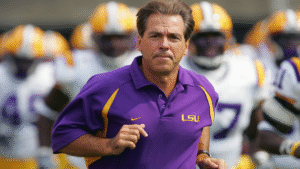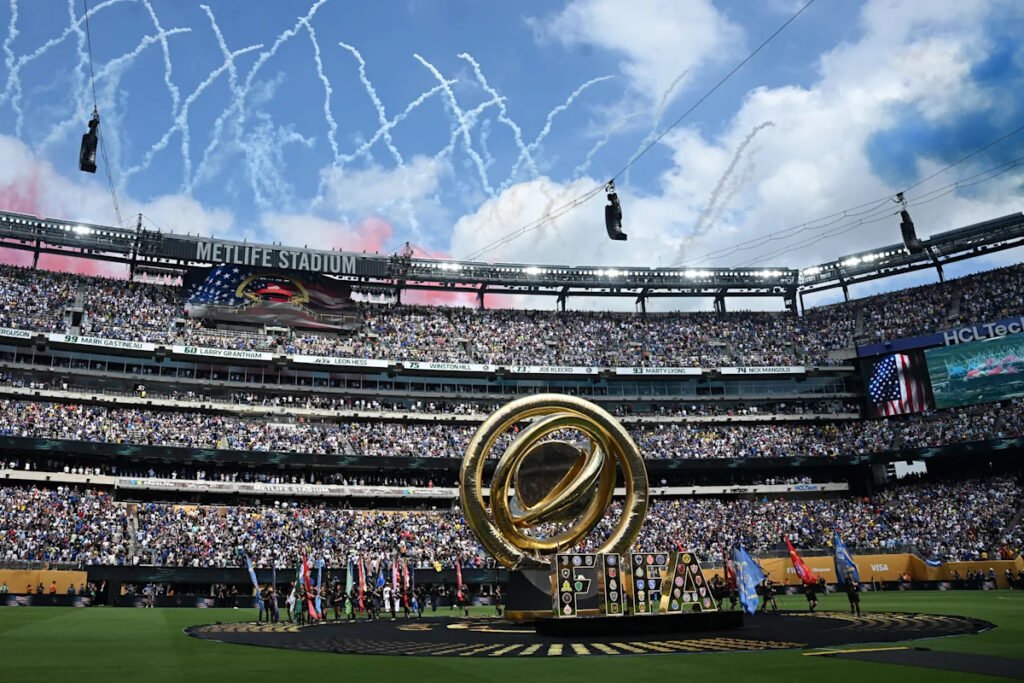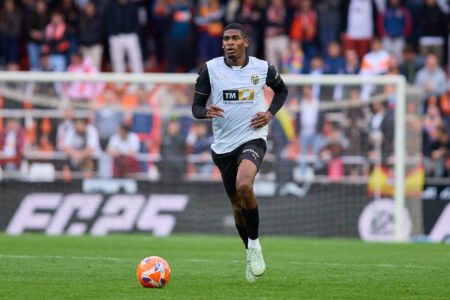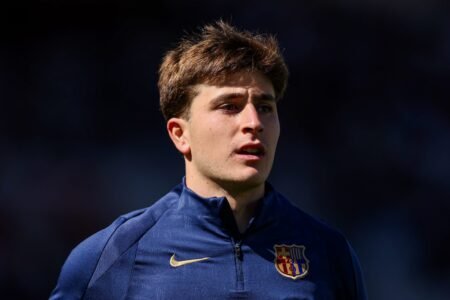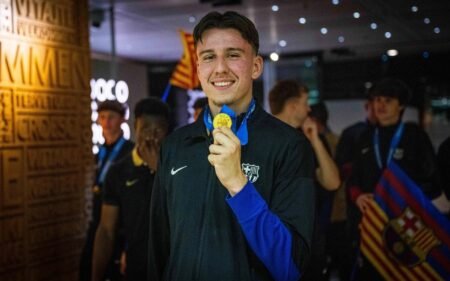EAST RUTHERFORD, N.J. — The uniformed soldiers marched onto MetLife Stadium’s temporary grass at 2:51 p.m., nine minutes before Sunday’s Club World Cup final was supposed to begin.
A public address announcer asked fans, who’d come from around the globe, to rise and remove their hats for the singing of the national anthem — so, although some were confused, they did.
Advertisement
They paused their own songs. They stood in silence and deference to their host. They watched a classic display of Americana, with stars and stripes displayed on video boards, and fireworks eventually ringing the stadium, accompanied by smoke colored red, white and blue.
And then, for 12 more minutes, under a hot and heating afternoon sun, they waited.
They waited for military jets to zoom through the sky. They waited for 22 players to parade across the field, each introduced individually, NBA-style. They waited for Michael Buffer, the famous American boxing announcer, to welcome, “in the blue corner, the six-time champions of Europe, and two-time European champions, born in 1905, hailing from Stamford Bridge on Kings Road in London … Chelseeeeaaaa!” They sat through a similar spiel for PSG. Players waited too, in formation, for a full minute.
And finally, at 3:08 p.m., on a day seen as a precursor for the 2026 World Cup, America ceded the stage to a soccer game.
Advertisement
Chelsea won that game, and this first-of-its-kind Club World Cup. But the tournament’s significance stretched beyond results. It was a “dress rehearsal” for the United States, which will host 78 of 104 games at next summer’s bigger, grander, more prestigious men’s World Cup. It was a “test” of readiness, and a taste of what 2026 will be like.
And in that sense, it was a reminder that 2026 won’t just be a World Cup in North America; it will be an Americanized World Cup.
Red, white and blue fireworks went off ahead of the FIFA Club World Cup 2025 final Sunday in New Jersey. (Photo by PAUL ELLIS/AFP via Getty Images)
(PAUL ELLIS via Getty Images)
The Americanization of the World Cup
From the use of dynamic pricing to in-stadium DJs, from the Joint Armed Forces Color Guard to flyovers at the opener and final, FIFA leaned heavily into American customs at the Club World Cup.
Advertisement
Whereas national anthems aren’t typically played before club soccer games, the “Star-Spangled Banner” was often played around an hour before kickoff.
And whereas soccer games in Europe almost always start precisely at the listed time, Club World Cup games regularly began several minutes past the hour — like Major League Baseball games and MLS matches always do.
Whereas soccer teams traditionally walk onto the field in unison, 11 players in a line, FIFA had them enter one by one. The individualized intros, like those before a basketball game, reflected “the innovative nature of this inaugural tournament,” a FIFA spokesman wrote in an email. But they did not seem super popular internationally. “I don’t like that,” Al Hilal defender João Cancelo said during the group stage. “I [prefer to] walk as a group.”
Whereas international soccer fans prefer to give games their own a cappella soundtrack, with chants crescendoing in the hour before kickoff, Club World Cup stadiums blared pop music during that hour.
Advertisement
And at the final, FIFA staged a pre-match musical performance and a halftime show — which stretched the interval between halves to 24 minutes, rather than the typical 15, not unlike the Super Bowl. (Roughly half of the fans in attendance went to MetLife Stadium’s concourses during halftime anyway.)
Some of this, like “Ref Cam,” fits into the aforementioned “innovation” category. Some of it is the Americanization of the tournament(s) and, more broadly, the sport. To an extent, World Cups always conform to local customs. But Sunday’s pageantry was far more patriotic than anything at Qatar 2022 or previous FIFA tournaments. And in all likelihood, it’s a sign of things to come next summer.
Heat and ‘unacceptable conditions’
The most impactful American feature, though — a constant topic of conversation and workplace hazard throughout the Club World Cup — was heat. Multiple players and coaches used the word “impossible” to describe the conditions. Chelsea’s Enzo Fernandez said he “got a little dizzy from playing” in mid-90s temperatures and “had to go on the ground.” Real Madrid’s Trent Alexander-Arnold said he was “overheating” and struggling to “think straight.”
Advertisement
“It’s very dangerous,” Fernandez said.
Exacerbating concerns and danger were the kickoff times. FIFA, the global soccer governing body that runs both the Club World Cup and big World Cup, scheduled more than half of this summer’s games — 32 of 63 — for 4 p.m. or earlier at outdoor stadiums.
“The timing is great for European fans, but the teams are suffering,” PSG coach Luis Enrique said. “In terms of play, it’s impossible to perform at a very high level for 90 minutes.”
Weeks later, Fernandez echoed that sentiment: “Let’s hope, for next year, they change the times so that, above all, the soccer continues to be nice and attractive.”
Advertisement
FIFPRO, an umbrella organization representing players and their unions worldwide, has also called on FIFA to prioritize health and safety “over commercial interests.” But it’s unclear if FIFA will listen. FIFPRO’s president, Sergio Marchi, recently accused FIFA of organizing tournaments in an “authoritarian” and “unilateral” manner. FIFA also increasingly optimizes match times for TV viewers in Europe and elsewhere. It caters to sponsors and broadcasters, who prefer each match in a unique window. With 104 games jammed into 39 days next summer, there will be at least four per day throughout the group stage, and therefore some in the afternoon.
FIFA will have the advantage of five covered stadiums next summer, compared to just one at this summer’s Club World Cup. It plans to use those stadiums — BC Place in Vancouver, SoFi Stadium in Southern California, AT&T Stadium near Dallas, NRG Stadium in Houston and Mercedes-Benz Stadium in Atlanta — for afternoon games.
But there are 10 group-stage days with three or more games slated for open-air stadiums. And five of eight games from the quarterfinals onward — games that Europe will expect in prime time — will be outdoors.
“Of course, the heat is an issue,” FIFA president Gianni Infantino acknowledged Saturday. He called cooling breaks “very important” and said: “We will see what we can do.”
Advertisement
Players have urged them to do more. FIFPRO’s Marchi said in a Sunday statement: “The [Club World Cup] was held under unacceptable conditions, with matches played at extremely hot times and in temperatures that put the players’ physical safety at risk. This situation must not only be denounced, but must be firmly warned against. What happened cannot be repeated under any circumstances at next year’s FIFA World Cup.”
Players, by the way, aren’t the only ones who suffered. Over the past month, afternoon starts and summer heat made the match-going experience uncomfortable for fans. With many of the 11 U.S. stadiums surrounded by asphalt deserts (parking lots), organizers will need to care for attendees with temporary structures for shade and readily available drinking water.
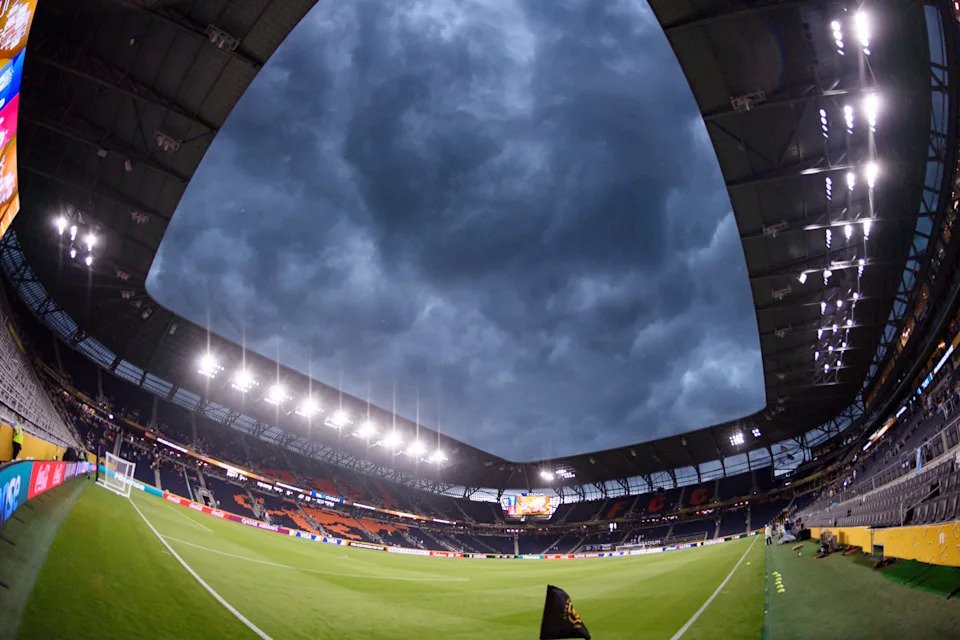
A Club World Cup match between CF Pachuca and FC Salzburg was interrupted due to harsh weather at TQL Stadium on June 18, 2025 in Cincinnati, Ohio. (Photo by Marcio Machado/Eurasia Sport Images/Getty Images)
(Eurasia Sport Images via Getty Images)
Weather delays
Another climatic concern is lightning and thunderstorms. Six Club World Cup matches — though only one in a 2026 World Cup host city — were suspended for at least 30 minutes by “severe weather.” Chelsea coach Enzo Maresca, fed up by a two-hour delay near the end of a Round of 16 match, called it a “joke” and questioned whether the U.S. was a suitable host for the tournament.
Advertisement
The situations in Charlotte, Orlando, Nashville and Cincinnati probably oversold the extent of the problem. But thunderstorms are indeed far more common in the U.S. than in Europe and other regions. They delay Major League Soccer games every summer. They were one reason FIFA considered putting the 2026 World Cup final at the indoor AT&T Stadium in Texas rather than outdoors in North Jersey, according to people with second-hand knowledge of the decision-making process.
“What you’re seeing right now is very typical. This is not unusual at all,” Ben Schott, the National Weather Service’s operations chief, told The Athletic after multiple Club World Cup delays. “Next year, we may be going through the same thing.”
‘The pitches are not so good’
The other source of frequent complaint was the temporary grass fields installed atop artificial turf for the tournament.
Advertisement
“The pitches are not so good,” Chelsea’s Reece James said Sunday. “Hopefully, there’s some changes for the World Cup next year.”
FIFA and organizers insist there will be changes. Much of their research, stadium renovations and agronomy innovations have specifically targeted 2026. Some key infrastructure was not yet ready or in use at the Club World Cup. For the World Cup, runways are longer and plans are more intensive.
Still, though, the Club World Cup cast some doubt on how effective those 2026 plans will be. The innovative “shallow pitch profile” described in my March 2025 feature on the subject was used at MetLife Stadium over the past month, officials familiar with the surface said. It did not shield the stadium from criticism.
James, when asked about the North Jersey stadium after playing a semifinal and final there, said of the pitch: “It’s not the best for the body, for the joints, for the muscles. You would see higher-quality games, and high-quality football, if we played on a surface which we play on in Europe.”
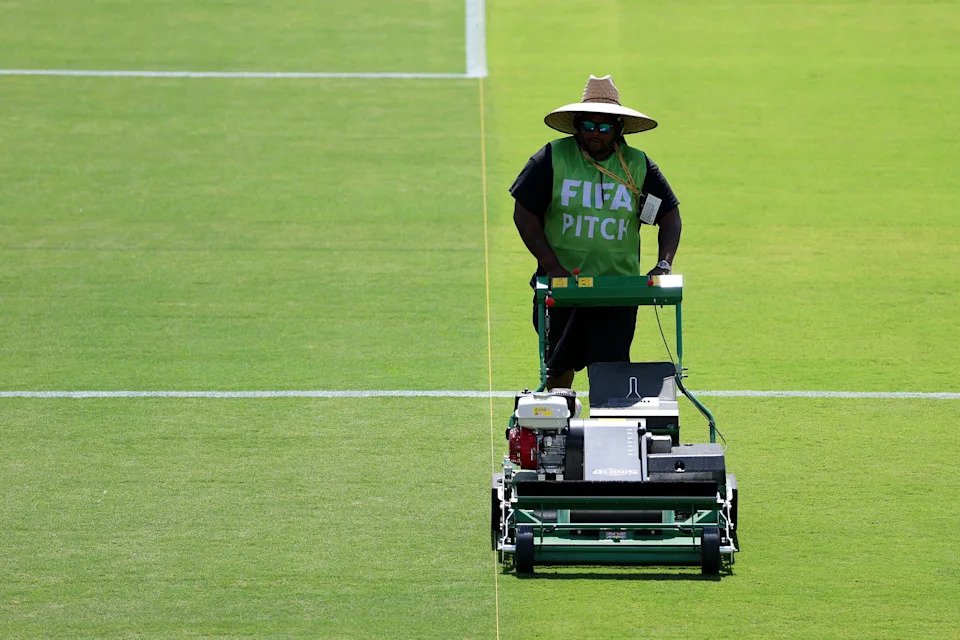
Field staff roll the grass on the pitch prior to the FIFA Club World Cup 2025 group E match between Urawa Red Diamonds and CF Monterrey at Rose Bowl Stadium on June 25, 2025 in Pasadena, California. (Photo by Sean M. Haffey – FIFA/FIFA via Getty Images)
(Sean M. Haffey – FIFA via Getty Images)
Lots of travel and traffic
In Europe, players are also accustomed to ground transport. They bus around England or Germany, or other compact countries, to games. Fans take public transportation. Flights and parking lots are foreign concepts — and, therefore, yet another challenge in the sprawling States.
Advertisement
At the last men’s World Cup, in Qatar, all eight stadiums were within an hour of one another, and mostly accessible via metro and/or shuttle. Teams settled in at base camps in or around Doha, and stayed there for the duration of the tournament.
In the U.S., on the other hand, they’ll be hopping on airplanes every few days. Multiple players and coaches mentioned this as a difficulty at the Club World Cup — and something to which they’ll need to adapt next summer. (Multiple teams, including Bayern Munich and Real Madrid, also had flights delayed by weather.)
Fans, meanwhile, dealt with obscene traffic. Some U.S. venues, such as Hard Rock Stadium in South Florida, are not equipped to deal with anything other than American car culture. With some parking lots blocked off for security reasons, and public transit systems lacking, out-of-town fans had very few options other than rideshare apps — which, at Hard Rock, left them stuck in standstills on surrounding roads, and/or needing to walk for miles.
Transport plans in Seattle, Philadelphia and New Jersey seemed to work reasonably well. But in many cases, stadiums were only half full. The 2026 World Cup, with more visitors and more extensive security perimeters, will be an entirely different animal. To that point, the second Club World Cup semifinal at MetLife was a bit portentous; kickoff was delayed 10 minutes because team buses got stuck in traffic en route.
Advertisement
U.S. stadiums pass their fan-management tests
Inside stadiums, though, local authorities seemed to handle foreign fans reasonably well.
This was a concern entering the Club World Cup, especially after last summer’s Copa América: How would law enforcement and stadium security manage supporters of clubs like Palmeiras, Wydad or Boca Juniors, whose passion is unlike anything they’ve ever experienced?
In most cases, they passed their test.
There were occasional issues — Flamengo fans said “security chose aggression over understanding” at Hard Rock Stadium, and expelled a majority of their drummers — but several stressful situations were defused with professionalism. At Hard Rock, I witnessed security personnel persuade hundreds of Boca fans to stop standing on seats; four days later, I witnessed armed, helmeted counterterrorism police clear out the aisles of sections that were getting overcrowded. In a few cases, they were excessively forceful, and kicked out fans who had tickets. But they largely kept calm and, most importantly, kept everyone safe.
Advertisement
The key, this summer and next — as a variety of officials told me prior to the tournament — is understanding that the vast majority of these traveling fans aren’t troublemakers; they merely express their love for their teams in ways that aren’t customary here in the States. In one pre-match briefing, before gates opened to Boca and Bayern Munich fans, a supervisor from the security company BEST put it well: “Remember what I told you,” he said to dozens of event staffers. “Stay focused. These guys — they’re really into the soccer game; and they’re sneaky.”
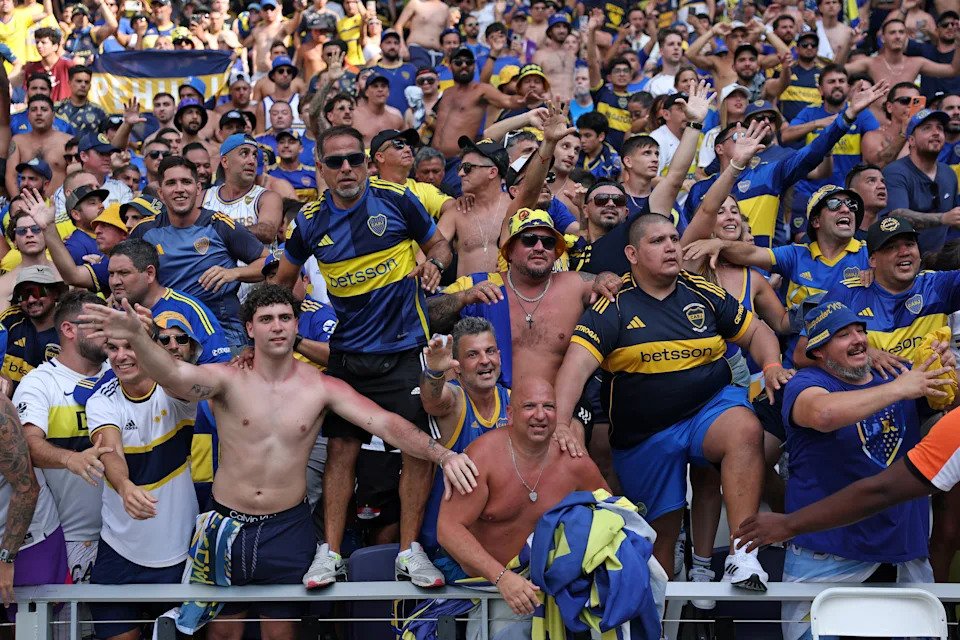
CA Boca Juniors fans interact with players as they exit the pitch following the FIFA Club World Cup 2025 group C match between Auckland City FC and CA Boca Juniors at GEODIS Park on June 24, 2025 in Nashville, Tennessee. (Photo by Patrick Smith – FIFA/FIFA via Getty Images)
(Patrick Smith – FIFA via Getty Images)
A variety of atmospheres
Those zealous fans from South America, North Africa and elsewhere also breathed life into the tournament. The most awe-inspiring atmospheres weren’t at semifinals or the final; they were for group games involving clubs like Boca, Flamengo, Espérance Tunis and Al Ahly.
Advertisement
Although the latter stages were better-attended, the crowds at MetLife last week felt more soccer-touristy. At the final, I saw hundreds of fans wearing jerseys with no connection to Chelsea or PSG, including: Al Nassr, Inter Miami, Manchester United, Independiente, Pumas, São Paulo, Paraguay, Colombia, Real Madrid, Inter Milan, Costa Rica, Germany, Alianza Lima, Cameroon, D.C. United, New York Cosmos, New York Knicks, Boston Celtics, Colo-Colo and the U.S. women’s national team.
That, in a nutshell, is probably a pretty accurate predictor of 2026 World Cup crowd demographics. Hundreds of thousands of fans will travel from abroad to follow their country’s national team. But, with foreign travel limited by strict visa laws and the cost of traveling to the U.S., millions of ticket buyers will come with no affiliation, either to see high-level soccer or the world’s most popular sporting event, or even just to take in the show.
Will 2026 World Cup stadiums be full?
The assumption, for years, has been that all World Cup games will sell out; that demand for tickets will shoot through roofs. The Club World Cup didn’t necessarily dispel that assumption, but it did offer a reminder: full stadiums aren’t guaranteed.
Advertisement
Across 63 games, the Club World Cup filled 61% of listed stadium capacities. It attracted over 2 million fans, but also left more than 1.5 million seats empty. Attendance numbers varied widely from game to game and, more instructively, from team to team. Real Madrid’s six matches were 94% full; hardly anybody, however, showed up to watch Ulsan HD or Mamelodi Sundowns.
The question is: Will that pattern repeat itself next summer? Argentina will fill stadiums; but what about New Zealand and Uzbekistan?
The answer probably depends on FIFA’s ticket pricing. Initial Club World Cup prices alarmed would-be buyers. Everyone expects 2026 tickets to be even more expensive. Organizers say they’ll go on sale sometime over the next few months.
Advertisement
Trump, front and center
One notable fan will definitely be there: U.S. President Donald Trump. He’ll be part of the tournament’s Americanization. He became one of the biggest stories of the Club World Cup final when, contrary to what players had been told, he stood next to James, Chelsea’s captain, for the trophy lift. “They told me he was going to present the trophy, and then exit the stage,” James said afterward. “But I think he wanted to stay.”
Ever since his election in November, insiders have expected Trump to be front and center in 2026. The assumption was that, in exchange for governmental support, Infantino would give Trump any self-promotional opportunity he wanted. Earlier in the Club World Cup, for example, the two brought a group of Juventus players and executives to the Oval Office, where they awkwardly stood behind Trump as he answered questions about Iran and travel bans.
But on Sunday, apparently unilaterally, Trump went a step further. Infantino seemingly tried to lead him away, so that the Chelsea players could have their (apolitical) moment. Trump seemingly refused.
Advertisement
“I knew he was going to be here, but I didn’t know he was going to be on the stand where we lift the trophy,” Chelsea midfielder Cole Palmer said. “So, I was a bit confused.”
The 2026 event, which the U.S. will co-host with Canada and Mexico, is inherently political. World Cups always are. But Trump’s presence, his close alliance with Infantino, and his America First policies — which seem to contradict much of what the World Cup stands for — will be particularly inescapable. They’ll attract some of his supporters to the tournament, and alienate many others who, as they do every four years, would simply like to enjoy the soccer.
Read the full article here

